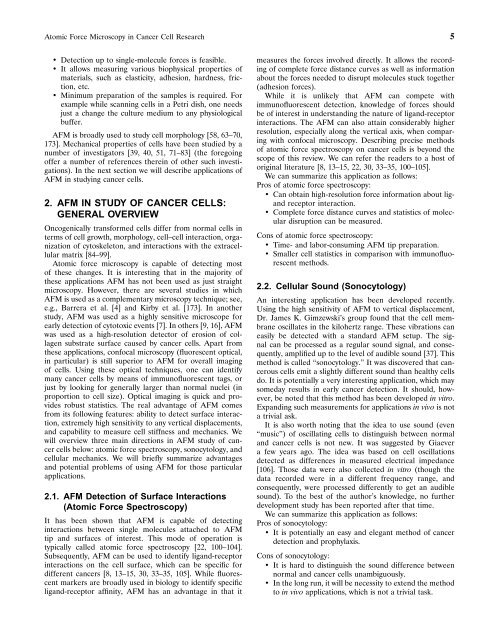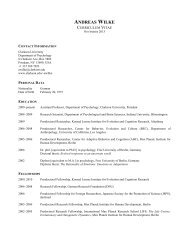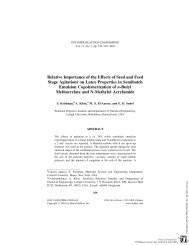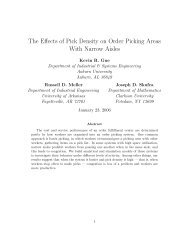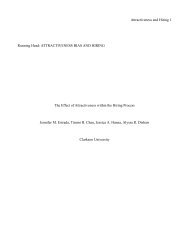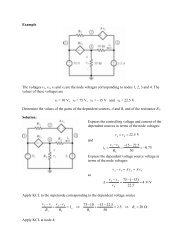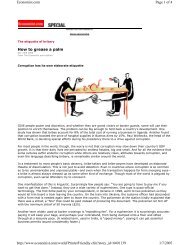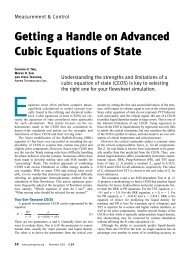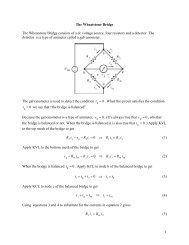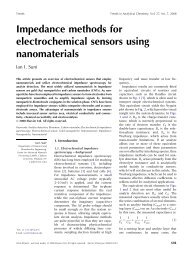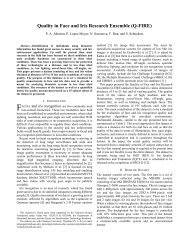Atomic Force Microscopy in Cancer Cell Research - Clarkson ...
Atomic Force Microscopy in Cancer Cell Research - Clarkson ...
Atomic Force Microscopy in Cancer Cell Research - Clarkson ...
You also want an ePaper? Increase the reach of your titles
YUMPU automatically turns print PDFs into web optimized ePapers that Google loves.
<strong>Atomic</strong> <strong>Force</strong> <strong>Microscopy</strong> <strong>in</strong> <strong>Cancer</strong> <strong>Cell</strong> <strong>Research</strong> 5<br />
• Detection up to s<strong>in</strong>gle-molecule forces is feasible.<br />
• It allows measur<strong>in</strong>g various biophysical properties of<br />
materials, such as elasticity, adhesion, hardness, friction,<br />
etc.<br />
• M<strong>in</strong>imum preparation of the samples is required. For<br />
example while scann<strong>in</strong>g cells <strong>in</strong> a Petri dish, one needs<br />
just a change the culture medium to any physiological<br />
buffer.<br />
AFM is broadly used to study cell morphology [58, 63–70,<br />
173]. Mechanical properties of cells have been studied by a<br />
number of <strong>in</strong>vestigators [39, 40, 51, 71–83] (the forego<strong>in</strong>g<br />
offer a number of references there<strong>in</strong> of other such <strong>in</strong>vestigations).<br />
In the next section we will describe applications of<br />
AFM <strong>in</strong> study<strong>in</strong>g cancer cells.<br />
2.AFM IN STUDY OF CANCER CELLS:<br />
GENERAL OVERVIEW<br />
Oncogenically transformed cells differ from normal cells <strong>in</strong><br />
terms of cell growth, morphology, cell–cell <strong>in</strong>teraction, organization<br />
of cytoskeleton, and <strong>in</strong>teractions with the extracellular<br />
matrix [84–99].<br />
<strong>Atomic</strong> force microscopy is capable of detect<strong>in</strong>g most<br />
of these changes. It is <strong>in</strong>terest<strong>in</strong>g that <strong>in</strong> the majority of<br />
these applications AFM has not been used as just straight<br />
microscopy. However, there are several studies <strong>in</strong> which<br />
AFM is used as a complementary microscopy technique; see,<br />
e.g., Barrera et al. [4] and Kirby et al. [173]. In another<br />
study, AFM was used as a highly sensitive microscope for<br />
early detection of cytotoxic events [7]. In others [9, 16], AFM<br />
was used as a high-resolution detector of erosion of collagen<br />
substrate surface caused by cancer cells. Apart from<br />
these applications, confocal microscopy (fluorescent optical,<br />
<strong>in</strong> particular) is still superior to AFM for overall imag<strong>in</strong>g<br />
of cells. Us<strong>in</strong>g these optical techniques, one can identify<br />
many cancer cells by means of immunofluorescent tags, or<br />
just by look<strong>in</strong>g for generally larger than normal nuclei (<strong>in</strong><br />
proportion to cell size). Optical imag<strong>in</strong>g is quick and provides<br />
robust statistics. The real advantage of AFM comes<br />
from its follow<strong>in</strong>g features:ability to detect surface <strong>in</strong>teraction,<br />
extremely high sensitivity to any vertical displacements,<br />
and capability to measure cell stiffness and mechanics. We<br />
will overview three ma<strong>in</strong> directions <strong>in</strong> AFM study of cancer<br />
cells below:atomic force spectroscopy, sonocytology, and<br />
cellular mechanics. We will briefly summarize advantages<br />
and potential problems of us<strong>in</strong>g AFM for those particular<br />
applications.<br />
2.1. AFM Detection of Surface Interactions<br />
(<strong>Atomic</strong> <strong>Force</strong> Spectroscopy)<br />
It has been shown that AFM is capable of detect<strong>in</strong>g<br />
<strong>in</strong>teractions between s<strong>in</strong>gle molecules attached to AFM<br />
tip and surfaces of <strong>in</strong>terest. This mode of operation is<br />
typically called atomic force spectroscopy [22, 100–104].<br />
Subsequently, AFM can be used to identify ligand-receptor<br />
<strong>in</strong>teractions on the cell surface, which can be specific for<br />
different cancers [8, 13–15, 30, 33–35, 105]. While fluorescent<br />
markers are broadly used <strong>in</strong> biology to identify specific<br />
ligand-receptor aff<strong>in</strong>ity, AFM has an advantage <strong>in</strong> that it<br />
measures the forces <strong>in</strong>volved directly. It allows the record<strong>in</strong>g<br />
of complete force distance curves as well as <strong>in</strong>formation<br />
about the forces needed to disrupt molecules stuck together<br />
(adhesion forces).<br />
While it is unlikely that AFM can compete with<br />
immunofluorescent detection, knowledge of forces should<br />
be of <strong>in</strong>terest <strong>in</strong> understand<strong>in</strong>g the nature of ligand-receptor<br />
<strong>in</strong>teractions. The AFM can also atta<strong>in</strong> considerably higher<br />
resolution, especially along the vertical axis, when compar<strong>in</strong>g<br />
with confocal microscopy. Describ<strong>in</strong>g precise methods<br />
of atomic force spectroscopy on cancer cells is beyond the<br />
scope of this review. We can refer the readers to a host of<br />
orig<strong>in</strong>al literature [8, 13–15, 22, 30, 33–35, 100–105].<br />
We can summarize this application as follows:<br />
Pros of atomic force spectroscopy:<br />
• Can obta<strong>in</strong> high-resolution force <strong>in</strong>formation about ligand<br />
receptor <strong>in</strong>teraction.<br />
• Complete force distance curves and statistics of molecular<br />
disruption can be measured.<br />
Cons of atomic force spectroscopy:<br />
• Time- and labor-consum<strong>in</strong>g AFM tip preparation.<br />
• Smaller cell statistics <strong>in</strong> comparison with immunofluorescent<br />
methods.<br />
2.2. <strong>Cell</strong>ular Sound (Sonocytology)<br />
An <strong>in</strong>terest<strong>in</strong>g application has been developed recently.<br />
Us<strong>in</strong>g the high sensitivity of AFM to vertical displacement,<br />
Dr. James K. Gimzewski’s group found that the cell membrane<br />
oscillates <strong>in</strong> the kilohertz range. These vibrations can<br />
easily be detected with a standard AFM setup. The signal<br />
can be processed as a regular sound signal, and consequently,<br />
amplified up to the level of audible sound [37]. This<br />
method is called “sonocytology.” It was discovered that cancerous<br />
cells emit a slightly different sound than healthy cells<br />
do. It is potentially a very <strong>in</strong>terest<strong>in</strong>g application, which may<br />
someday results <strong>in</strong> early cancer detection. It should, however,<br />
be noted that this method has been developed <strong>in</strong> vitro.<br />
Expand<strong>in</strong>g such measurements for applications <strong>in</strong> vivo is not<br />
a trivial ask.<br />
It is also worth not<strong>in</strong>g that the idea to use sound (even<br />
“music”) of oscillat<strong>in</strong>g cells to dist<strong>in</strong>guish between normal<br />
and cancer cells is not new. It was suggested by Giaever<br />
a few years ago. The idea was based on cell oscillations<br />
detected as differences <strong>in</strong> measured electrical impedance<br />
[106]. Those data were also collected <strong>in</strong> vitro (though the<br />
data recorded were <strong>in</strong> a different frequency range, and<br />
consequently, were processed differently to get an audible<br />
sound). To the best of the author’s knowledge, no further<br />
development study has been reported after that time.<br />
We can summarize this application as follows:<br />
Pros of sonocytology:<br />
• It is potentially an easy and elegant method of cancer<br />
detection and prophylaxis.<br />
Cons of sonocytology:<br />
• It is hard to dist<strong>in</strong>guish the sound difference between<br />
normal and cancer cells unambiguously.<br />
• In the long run, it will be necessity to extend the method<br />
to <strong>in</strong> vivo applications, which is not a trivial task.


